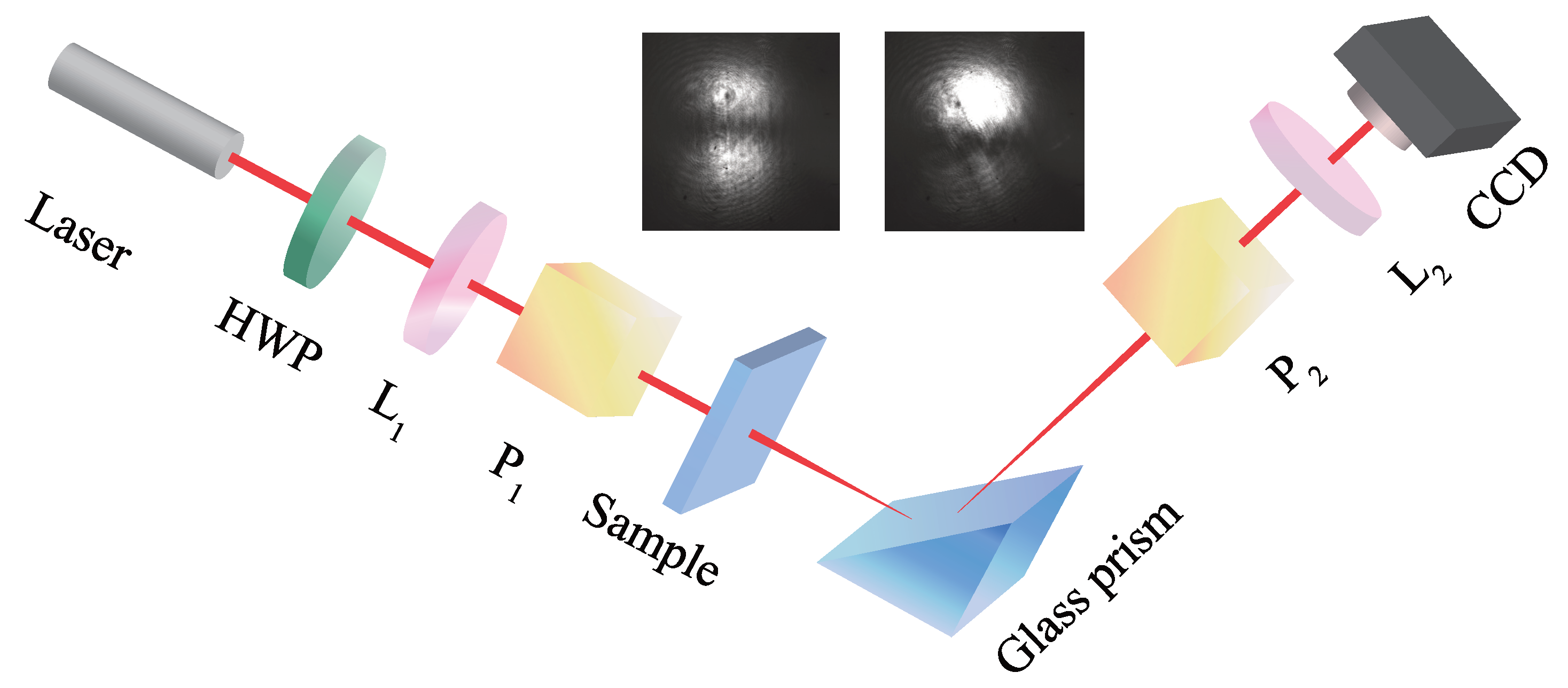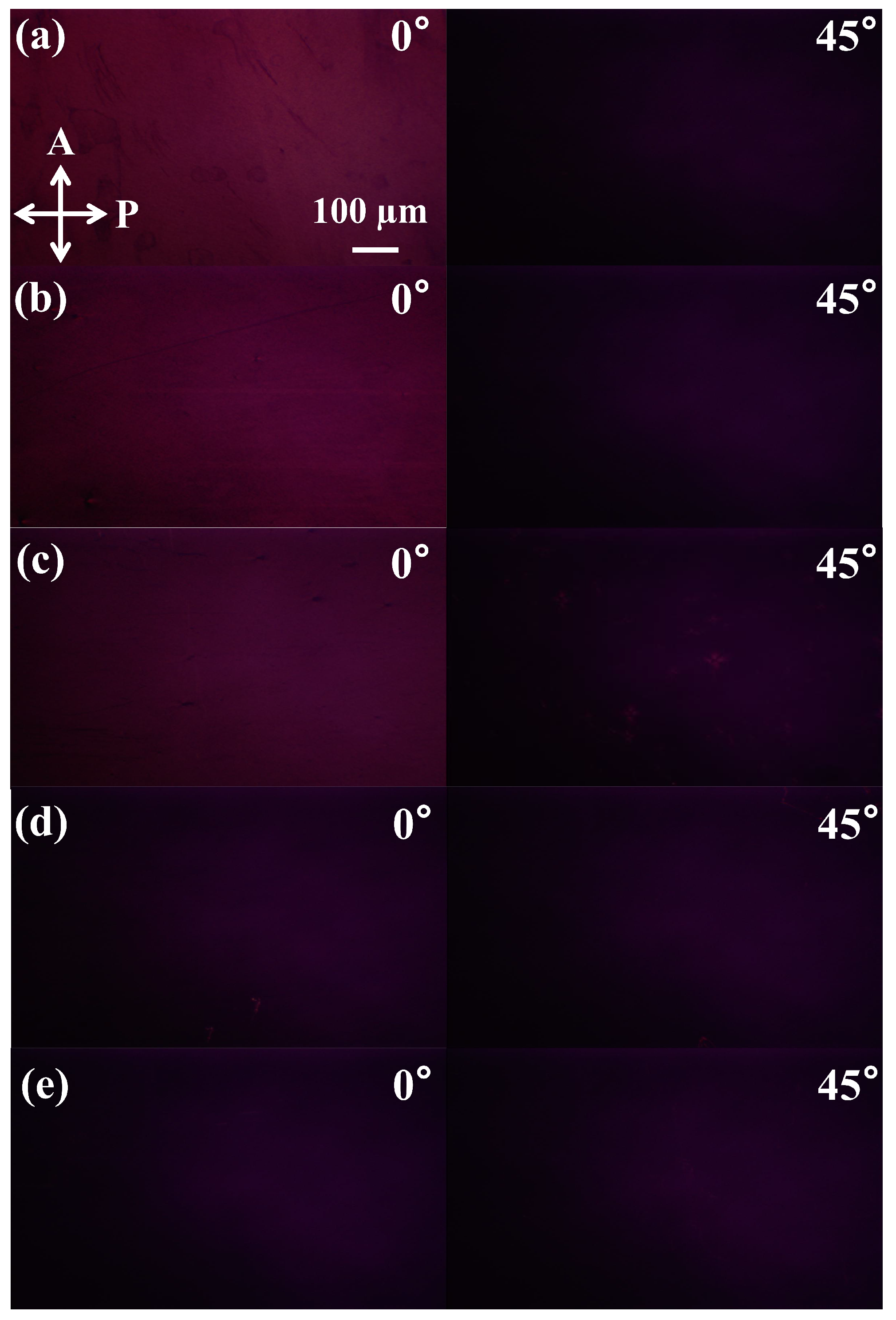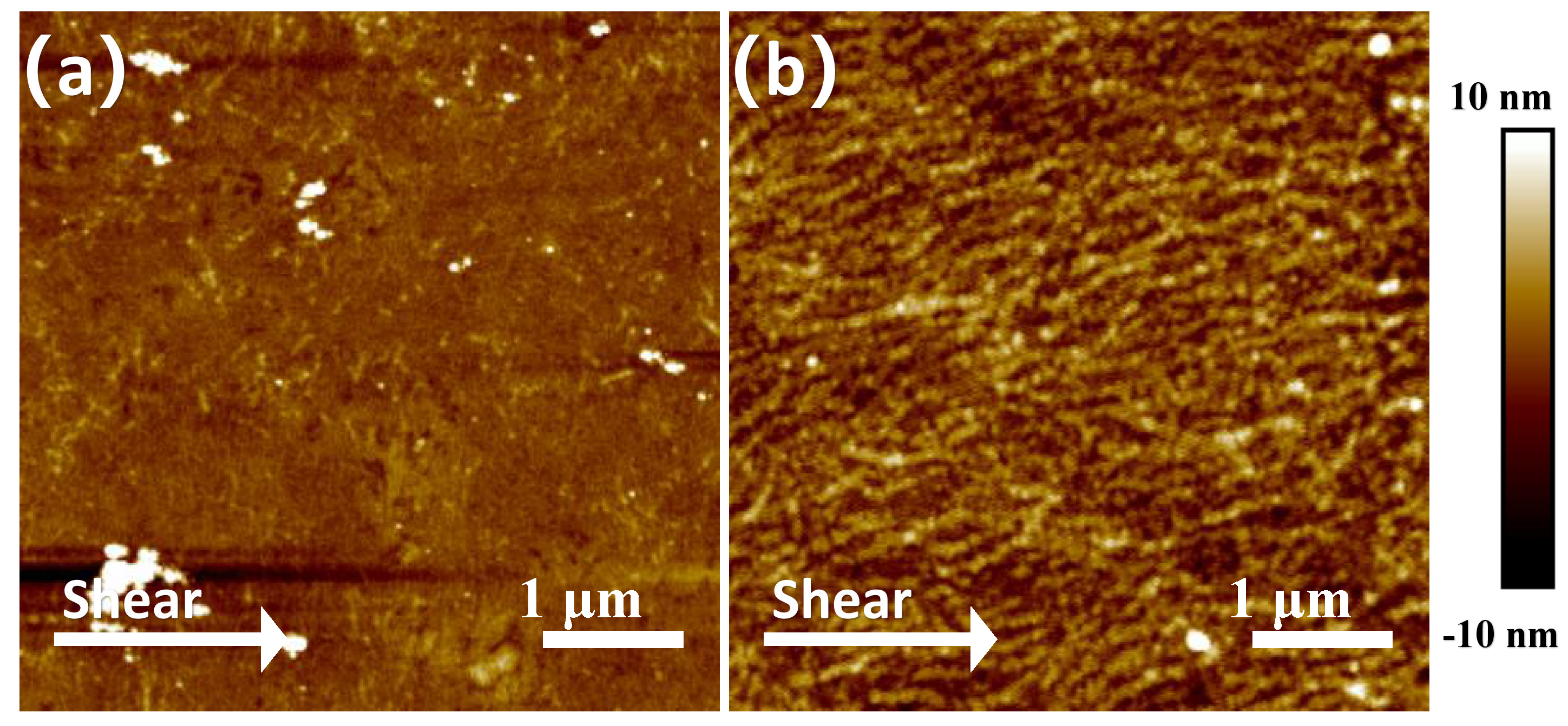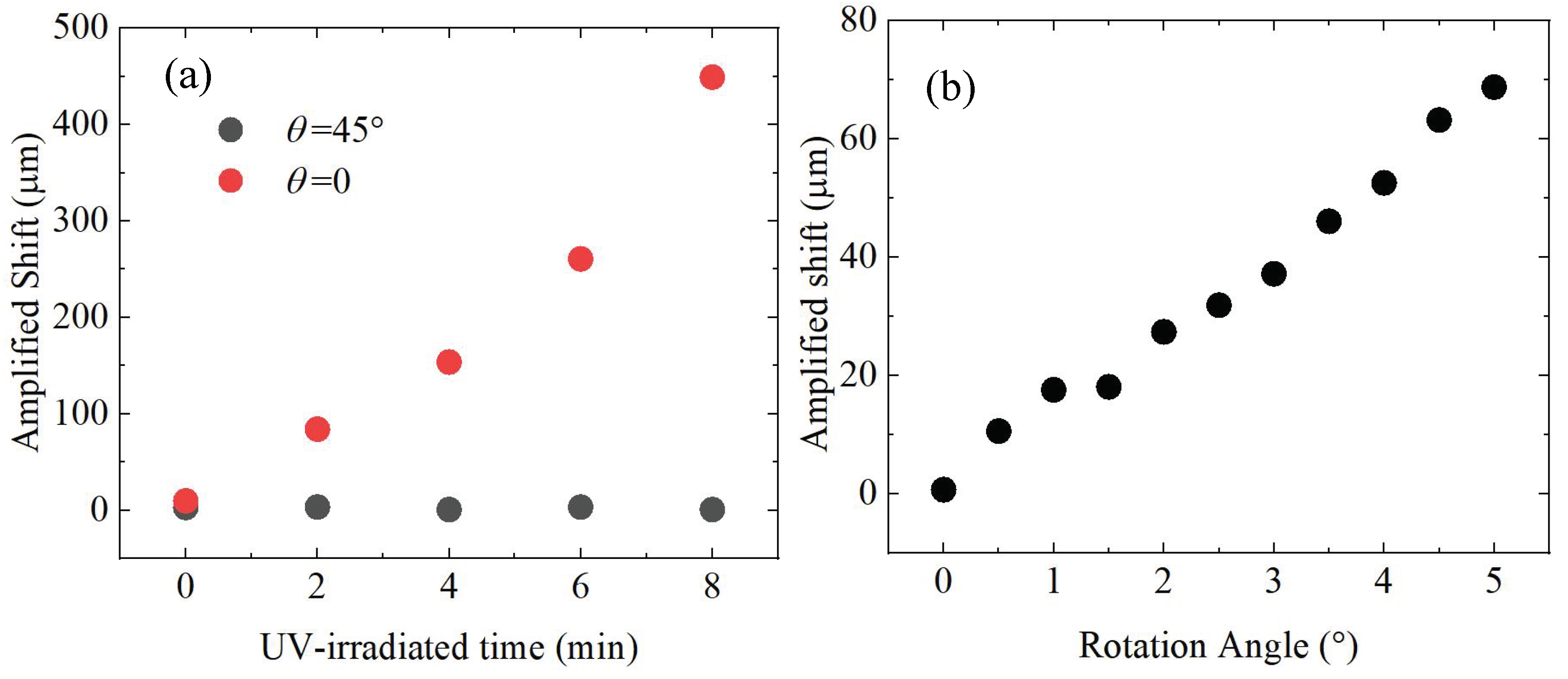Characterization of Aligned Polymers Using the Spin Hall Effect of Light
Abstract
:1. Introduction
2. Materials and Methods
2.1. Materials and Sample Preparation
2.1.1. Materials
2.1.2. Preparation of Aligned P3HT Films
2.2. Traditional Methods
2.2.1. UV–Vis Spectroscopy
2.2.2. Atomic Force Microscopy (AFM)
2.2.3. Polarized Optical Microscopy (POM)
2.3. Method of SHEL
2.3.1. Experimental Setup
2.3.2. Transmission in Aligned Polymers
2.3.3. Process of SHEL
3. Results and Discussion
3.1. Characterization of UV-Vis Spectroscopy
3.2. Characterization of POM
3.3. Characterization of AFM
3.4. Characterization of SHEL
4. Conclusions
Author Contributions
Funding
Institutional Review Board Statement
Data Availability Statement
Conflicts of Interest
References
- Chang, M.; Su, Z.; Egap, E. Alignment and Charge Transport of One-Dimensional Conjugated Polymer Nanowires in Insulating Polymer Blends. Macromolecules 2016, 49, 9449–9456. [Google Scholar]
- Giri, G.; Verploegen, E.; Mannsfeld, S.C.B.; Atahan-Evrenk, S.; Kim, D.H.; Lee, S.Y.; Becerril, H.A.; Aspuru-Guzik, A.; Toney, M.F.; Bao, Z. Tuning charge transport in solution-sheared organic semiconductors using lattice strain. Nature 2011, 480, 504–508. [Google Scholar]
- Vuks, M.F. Determination of the Optical Anisotropy of Aromatic Molecules from the Double Refraction of Crystals. Opt. Spectrosc. 1966, 20, 361. [Google Scholar]
- Hosten, O.; Kwiat, P. Observation of the spin Hall effect of light via weak measurements. Science 2008, 319, 787–790. [Google Scholar] [PubMed]
- Shitrit, N.; Yulevich, I.; Maguid, E.; Ozeri, D.; Veksler, D.; Kleiner, V.; Hasman, E. Spin-optical metamaterial route to spin-controlled photonics. Science 2013, 340, 724–726. [Google Scholar]
- Yin, X.; Ye, Z.; Rho, J.; Wang, Y.; Zhang, X. Photonic spin Hall effect at metasurfaces. Science 2013, 339, 1405–1407. [Google Scholar] [PubMed]
- Kapitanova, P.V.; Ginzburg, P.; Rodríguez-Fortuño, F.J.; Filonov, D.S.; Voroshilov, P.M.; Belov, P.A.; Poddubny, A.N.; Kivshar, Y.S.; Wurtz, G.A.; Zayats, A.V. Photonic spin Hall effect in hyperbolic metamaterials for polarization-controlled routing of subwavelength modes. Nat. Commun. 2014, 5, 1–8. [Google Scholar] [CrossRef]
- Gosselin, P.; Bérard, A.; Mohrbach, H. Spin Hall effect of photons in a static gravitational field. Phys. Rev. D 2007, 75, 084035. [Google Scholar]
- Dartora, C.A.; Cabrera, G.G.; Nobrega, K.Z.; Montagner, V.F.; Matielli, M.H.K.; de Campos, F.K.R.; Filho, H.T.S. Lagrangian-Hamiltonian formulation of paraxial optics and applications: Study of gauge symmetries and the optical spin Hall effect. Phys. Rev. A 2011, 83, 012110. [Google Scholar] [CrossRef]
- Bliokh, K.Y.; Gorodetski, Y.; Kleiner, V.; Hasman, E. Coriolis effect in optics: Unified geometric phase and spin-Hall effect. Phys. Rev. Lett. 2008, 101, 030404. [Google Scholar]
- Gorodetski, Y.; Niv, A.; Kleiner, V.; Hasman, E. Observation of the spin-based plasmonic effect in nanoscale structures. Phys. Rev. Lett. 2008, 101, 043903. [Google Scholar] [CrossRef] [PubMed]
- Shitrit, N.; Bretner, I.; Gorodetski, Y.; Kleiner, V.; Hasman, E. Optical spin Hall effects in plasmonic chains. Nano Lett. 2011, 11, 2038–2042. [Google Scholar] [CrossRef] [PubMed]
- Gorodetski, Y.; Bliokh, K.Y.; Stein, B.; Genet, C.; Shitrit, N.; Kleiner, V.; Hasman, E.; Ebbesen, T.W. Weak measurements of light chirality with a plasmonic slit. Phys. Rev. Lett. 2012, 109, 013901. [Google Scholar] [CrossRef] [PubMed]
- Ménard, J.M.; Mattacchione, A.E.; Betz, M.; van Driel, H.M. Imaging the spin Hall effect of light inside semiconductors via absorption. Opt. Lett. 2009, 34, 2312–2314. [Google Scholar] [CrossRef]
- Ménard, J.M.; Mattacchione, A.E.; van Driel, H.M.; Hautmann, C.; Betz, M. Ultrafast optical imaging of the spin Hall effect of light in semiconductors. Phys. Rev. B 2010, 82, 045303. [Google Scholar] [CrossRef]
- Aiello, A.; Lindlein, N.; Marquardt, C.; Leuchs, G. Transverse angular momentum and geometric spin Hall effect of light. Phys. Rev. Lett. 2009, 103, 100401. [Google Scholar] [CrossRef]
- Li, D.; Guan, T.; Liu, F.; Yang, A.; He, Y.; He, Q.; Shen, Z.; Xin, M. Optical rotation based chirality detection of enantiomers via weak measurement in frequency domain. Appl. Phys. Lett. 2018, 112, 213701. [Google Scholar]
- Xiao, J.; Tang, T.; Liang, X.; Liu, K.; Tang, Y.; Li, J.; Li, C. Chirality and concentration detection of biomolecules based on spin Hall effect of light. Phys. Lett. A 2021, 416, 127692. [Google Scholar] [CrossRef]
- Wang, Y.; Yang, S.; Zhang, Q.; Chen, Y.; Hu, X.; Zhang, H.; Zhang, Z. Complete chiroptical signal detection using weak measurement with intensity-contrast-ratio pointers. APL Photonics 2023, 8, 126102. [Google Scholar] [CrossRef]
- Qiu, X.; Zhou, X.; Hu, D.; Du, J.; Gao, F.; Zhang, Z.; Luo, H. Determination of magneto-optical constant of Fe films with weak measurements. Appl. Phys. Lett. 2014, 105, 131111. [Google Scholar]
- Wang, Q.; Li, T.; Luo, L.; He, Y.; Liu, X.; Li, Z.; Zhang, Z.; Du, J. Measurement of hysteresis loop based on weak measurement. Opt. Lett. 2020, 45, 1075–1078. [Google Scholar] [PubMed]
- Li, T.; Wang, Q.; Taallah, A.; Zhang, S.; Yu, T.; Zhang, Z. Measurement of the magnetic properties of thin films based on the spin Hall effect of light. Opt. Express 2020, 28, 29086–29097. [Google Scholar] [CrossRef]
- Takayama, O.; Puentes, G. Enhanced spin Hall effect of light by transmission in a polymer. Opt. Lett. 2018, 43, 1343–1346. [Google Scholar] [CrossRef] [PubMed]
- Puentes, G. Spin-Orbit Interactions of Light: Fundamentals and Emergent Applications. J. Eur. Opt.-Soc.-Rapid Publ. 2024, 20, 16. [Google Scholar]
- Aiyar, A.R.; Hong, J.I.; Nambiar, R.; Collard, D.M.; Reichmanis, E. Tunable Crystallinity in Regioregular Poly(3-Hexylthiophene) Thin Films and Its Impact on Field Effect Mobility. Adv. Funct. Mater. 2011, 21, 2652–2659. [Google Scholar] [CrossRef]
- Chang, M.; Lee, J.; Kleinhenz, N.; Fu, B.; Reichmanis, E. Photoinduced Anisotropic Supramolecular Assembly and Enhanced Charge Transport of Poly(3-hexylthiophene) Thin Films. Adv. Funct. Mater. 2014, 24, 4457–4465. [Google Scholar]
- Bliokh, K.Y.; Samlan, C.T.; Prajapati, C.; Puentes, G.; Viswanathan, N.K.; Nori, F. Spin-Hall effect and circular birefringence of a uniaxial crystal plate. Optica 2016, 3, 1039–1047. [Google Scholar] [CrossRef]
- Farhang, C.; Wang, J.; Ortiz, B.R.; Wilson, S.D.; Xia, J. Unconventional specular optical rotation in the charge ordered state of Kagome metal CsV3Sb5. Nat. Commun. 2023, 14, 5326. [Google Scholar]






Disclaimer/Publisher’s Note: The statements, opinions and data contained in all publications are solely those of the individual author(s) and contributor(s) and not of MDPI and/or the editor(s). MDPI and/or the editor(s) disclaim responsibility for any injury to people or property resulting from any ideas, methods, instructions or products referred to in the content. |
© 2025 by the authors. Licensee MDPI, Basel, Switzerland. This article is an open access article distributed under the terms and conditions of the Creative Commons Attribution (CC BY) license (https://creativecommons.org/licenses/by/4.0/).
Share and Cite
Wang, C.; Li, T.; Zhang, S.; Xiong, Z.; Zhang, Z. Characterization of Aligned Polymers Using the Spin Hall Effect of Light. Polymers 2025, 17, 958. https://doi.org/10.3390/polym17070958
Wang C, Li T, Zhang S, Xiong Z, Zhang Z. Characterization of Aligned Polymers Using the Spin Hall Effect of Light. Polymers. 2025; 17(7):958. https://doi.org/10.3390/polym17070958
Chicago/Turabian StyleWang, Changyou, Tong Li, Sijie Zhang, Zuhong Xiong, and Zhiyou Zhang. 2025. "Characterization of Aligned Polymers Using the Spin Hall Effect of Light" Polymers 17, no. 7: 958. https://doi.org/10.3390/polym17070958
APA StyleWang, C., Li, T., Zhang, S., Xiong, Z., & Zhang, Z. (2025). Characterization of Aligned Polymers Using the Spin Hall Effect of Light. Polymers, 17(7), 958. https://doi.org/10.3390/polym17070958





